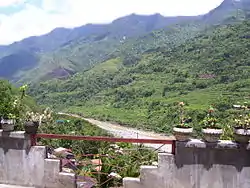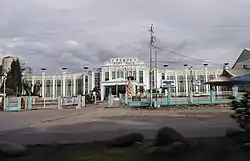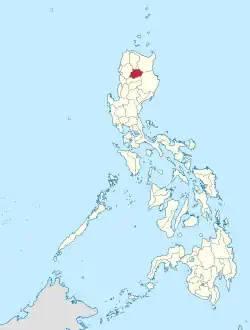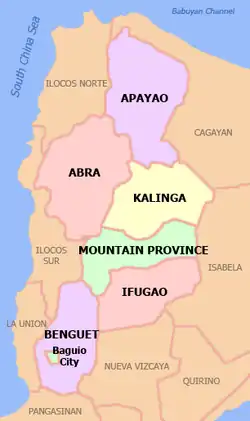Kalinga | |
|---|---|
| Province of Kalinga[1] | |
      (from top: left to right) Bum-bag Rice Terraces, Pasil Valley, Lubuagan Mountains, Mount Manting-oy, Mount Binuluan and Tabuk City Hall. | |
 Flag  Seal | |
 Location in the Philippines | |
OpenStreetMap | |
| Coordinates: 17°45′N 121°15′E / 17.75°N 121.25°E | |
| Country | Philippines |
| Region | Cordillera Administrative Region |
| Founded | May 8, 1995 |
| Capital and largest city | Tabuk |
| Government | |
| • Governor | James S. Edduba (Lakas) |
| • Vice Governor | Jocel C. Baac (Aksyon) |
| • Legislature | Kalinga Provincial Board |
| Area | |
| • Total | 3,231.25 km2 (1,247.59 sq mi) |
| • Rank | 41st out of 81 |
| Highest elevation | 2,617 m (8,586 ft) |
| Population (2020 census)[3] | |
| • Total | 229,570 |
| • Estimate (2020) | 220,329[4] |
| • Rank | 71st out of 81 |
| • Density | 71/km2 (180/sq mi) |
| • Rank | 78th out of 81 |
| Divisions | |
| • Independent cities | 0 |
| • Component cities | 1 |
| • Municipalities | |
| • Barangays | 153 |
| • Districts | Legislative district of Kalinga |
| Time zone | UTC+8 (PHT) |
| ZIP code | 3800–3808 |
| IDD : area code | +63 (0)74 |
| ISO 3166 code | PH-KAL |
| Spoken languages | |
| Website | www |
Kalinga (IPA: [kaliŋɡa]), officially the Province of Kalinga (Ilocano: Probinsia ti Kalinga; Tagalog: Lalawigan ng Kalinga), is a landlocked province in the Philippines situated within the Cordillera Administrative Region in Luzon. Its capital is Tabuk and borders Mountain Province to the south, Abra to the west, Isabela to the east, Cagayan to the northeast, and Apayao to the north. Kalinga and Apayao are the result of the 1995 partitioning of the former province of Kalinga-Apayao which was seen to better service the respective needs of the various indigenous peoples in the area.
Unbeknownst to many, President Emilio Aguinaldo proclaimed Lubuagan town the seat of government for 73 days from March 6, 1900, to May 18, 1900, before finally fleeing to Palanan.[5][6]
Etymology
The province's name is derived from the Ibanag and Gaddang noun "kalinga", which means "enemy", "fighter", or "headtaker".[7]
History
American occupation
Kalinga was taken from Cagayan and Isabela provinces and established by the US Government through Philippine Commission Act No. 1642 on May 9, 1907, as a sub-province of Lepanto-Bontoc.[8]
Kalinga was later organized as one of the sub-provinces of Mountain Province, created by Act No. 1876.[9]
In the early years, the subprovince underwent series of territorial changes. Part of Kalinga was transferred to another sub-province Bontoc through Executive Order No. 53 in 1914. In the municipal district of Pinukpuk, barrios were moved to Balbalan in 1926; as well as parts of it to Conner in Apayao in 1927.[10]
Philippine independence
Kalinga became part of a province along with Apayao when the old Mountain Province was divided into four separate provinces through Republic Act No. 4695 in 1966[9][11] and, with Abra, became part of the territories in the Cordillera Administrative Region which was created through Executive Order No. 220 in 1987.[12] Kalinga was converted into a province in 1995 by virtue of RA No. 7878 when majority of the voters in Kalinga-Apayao approved in a plebiscite the division of the province into two.[9][13]
Contemporary
On February 15, 2023, the province was certified by Guinness World Records with two titles: largest gong ensemble (in its second attempt) with 3,440 male participants, and largest banga (clay pot) dance with 4,681 female participants; both performed in a program called "Awong Chi Gangsa, Agtu'n Chi Banga" (A call of a thousand gongs, the dance of a thousand pots) in Tabuk, as part of the 4th Bodong Festival coinciding with the province's 28th founding anniversary.[14][15]
Geography

Kalinga covers a total area of 3,231.25 square kilometres (1,247.59 sq mi)[16] occupying the central section of the Cordillera Administrative Region in Luzon. The province is bordered by Mountain Province to the south, Abra to the west, Isabela to the east, Cagayan to the northeast, and Apayao to the north.
Large swaths of the province's lowlands are open grassland suitable for pasture, while the highlands have extensive areas of tropical rainforest. In higher elevations to the west, particularly in the mountains of Balbalan, lie some of the most intact pine forests of Luzon island. Rizal and Tabuk with their flatlands are the biggest rice producers. Next in rice production are the mountainous area, and of note are the rice terraces of Balbalan, Lubuagan, Pasil, Pinukpuk, Tinglayan, and Tanudan.
Climate
Hydrology

The province is drained mainly by the Chico River, with its headwaters in the Mountain Province and emptying into the Cagayan River. The Chico River has several tributaries: Bunog River in Tinglayan in the south; the Tanudan and Biga Rivers in the east; Pasil River in the central area; and Poswoy, Dao-angan, Mabaca and Saltan Rivers in the west.
Several small lakes can also be found in Kalinga.
Administrative divisions

Kalinga comprises one component city and seven municipalities, all encompassed by a single legislative district.
Tabuk was proclaimed a component city in 2007, but in November 2008 the Supreme Court of the Philippines ruled that its cityhood was unconstitutional. However, Tabuk had its city status reinstated by the Supreme Court on December 22, 2009.[17]

|
| |||||||||||||||||||||||||||||||||||||||||||||||||||||||||||||||||||||||||||||||||||||||||||||||||||||||||||||||||||||||||||||||||||||||||||||||||||||||||||||
Barangays
The seven municipalities and one component city of the province comprise 153 barangays, with Bulanao in Tabuk City as the most populous in 2010, and Anggacan Sur in Tanudan as the least. If the City of Tabuk is excluded, Pinukpuk Junction in Pinukpuk municipality has the highest population.[16]
Demographics
| Year | Pop. | ±% p.a. |
|---|---|---|
| 1903 | 17,660 | — |
| 1918 | 27,467 | +2.99% |
| 1939 | 31,320 | +0.63% |
| 1948 | 36,777 | +1.80% |
| 1960 | 59,927 | +4.15% |
| 1970 | 86,597 | +3.75% |
| 1975 | 102,110 | +3.36% |
| 1980 | 114,382 | +2.29% |
| 1990 | 137,055 | +1.83% |
| 1995 | 154,145 | +2.23% |
| 2000 | 174,023 | +2.63% |
| 2007 | 182,326 | +0.64% |
| 2010 | 201,613 | +3.73% |
| 2015 | 212,680 | +1.02% |
| 2020 | 229,570 | +1.51% |
| Source: Philippine Statistics Authority[18][19][20] | ||
The population of Kalinga in the 2020 census was 229,570 people,[3] with a density of 71 inhabitants per square kilometre or 180 inhabitants per square mile.
On the 2000 census survey, Kalinga people comprised 64.37% (111,774) of the total provincial population of 173,638. Ilocanos came in second at 23.98% (41,633), while other ethnic groups in the province were the Kankanaey at 2.55% (4,421), Bontoc at 1.61% (2,804), Tagalog at 1.28% (2,227) and Applai at 1% (1,730).[21]
The primary language spoken is Kalinga, including its dialects of Balangao, Butbut, Limos, Lower Tanudan, Lubuagan, Mabaka, Madukayang, Southern Kalingan, and Upper Tanudan. Gaddang, as well as Ilocano, Tagalog, and English are also spoken in as lingua francas with varying degrees of proficiency.
Economy
Culture


There are many sub-tribes in the province. The strong sense of tribal membership and filial loyalty results in frequent tribal unrest and occasional outright war. Due to the mountainous terrain and warrior-culture of the people, the Kalinga were able to preserve their culture despite centuries of occupation in the lowlands by the Spaniards, Americans, and the Japanese.
On February 22, 2019, the Department of Tourism announced the bid of Digdiga Ni Tupayya, a Kalinga courtship dance, to be included in the UNESCO Intangible Cultural Heritage Lists.[29][30]
Historic figures
- Macli-ing Dulag - a Kalinga warrior and leader (pangat) who opposed the Chico River Dam Project. Murdered by military personnel under the command of dictator Ferdinand Marcos. Dulag's death is remembered as one of the two occasions for the declaration of Cordillera Day in the entire Cordillera Administrative Region. His name has been inscribed in the heroes' marker in Quezon City.
- Conrado Balweg - a former Filipino Catholic priest and rebel who was the founder of the Cordillera People's Liberation Army, a militant group which advocated autonomy for the Cordillera region in the Philippines. He was also known by the nom-de-guerre Ka Ambo.
- Whang-od - a Kalinga master tattooist (mambabatok) and recipient of the prestigious Dangal ng Haraya Award.
- Alonzo Saclag - Awarded as a National Living Treasure for his efforts to preserve the culture of Kalinga through performing arts.
References
- ↑ (Ilocano: Probinsia ti Kalinga; Tagalog: Lalawigan ng Kalinga)
- ↑ "List of Provinces". PSGC Interactive. Makati, Philippines: National Statistical Coordination Board. Archived from the original on January 17, 2013. Retrieved January 2, 2014.
- 1 2 3 Census of Population (2020). Table B - Population and Annual Growth Rates by Province, City, and Municipality - By Region. Philippine Statistics Authority. Retrieved July 8, 2021.
- ↑ "POPULATION PROJECTIONS BY REGION, PROVINCE, CITIES AND MUNICIPALITIES, 2020-2025". www.doh.gov.ph. Department of Health. August 27, 2020. Archived from the original on May 14, 2021. Retrieved October 16, 2020.
- ↑ "History". Municipality of Lubuagan. Archived from the original on August 31, 2018. Retrieved March 14, 2019.
- ↑ "Municipality of Lubuagan". Department of Interior and Local Government-Cordillera Administrative Region. Archived from the original on March 22, 2016. Retrieved March 14, 2019.
- ↑ "Archived copy" (PDF). nlpdl.nlp.gov.ph:81. Archived from the original (PDF) on May 16, 2017. Retrieved June 30, 2022.
{{cite web}}: CS1 maint: archived copy as title (link) - ↑ "Act No. 1642". Supreme Court E-Library. Government of the Philippines. May 9, 1907. Retrieved July 24, 2022.
- 1 2 3 "The Kalinga". National Commission for Culture and the Arts. Government of the Philippines. Retrieved August 7, 2022.
- ↑ "Index to Official Gazette (1913–1928)" (PDF). University of San Carlos. The Library Corporation. 2011–2012. Retrieved July 31, 2022.
- ↑ "Republic Act No. 4695". The LawPhil Project. Arellano Law Foundation. June 18, 1966. Retrieved July 24, 2022.
- ↑ "Executive Order No. 220, s. 1987". Official Gazette (Philippines). Government of the Philippines. July 15, 1987. Retrieved August 7, 2022.
- ↑ "Memorandum Order No. 290, s. 1995". Official Gazette (Philippines). Government of the Philippines. July 5, 1995. Retrieved July 22, 2022.
- ↑ Dumlao, Artemio (February 17, 2023). "Kalinga snares 2 Guinness world records". The Philippine Star. Retrieved February 17, 2023.
- ↑ Visaya, Villamor Jr. (February 17, 2023). "Kalinga earns world records for gong players, 'banga' dancers". Philippine Daily Inquirer. Retrieved February 17, 2023.
- 1 2 3 "Province: Kalinga (province)". PSGC Interactive. Quezon City, Philippines: Philippine Statistics Authority. Retrieved January 8, 2016.
- ↑ Pulta, Benjamin B. (December 23, 2009). "SC reverses self, upholds creation of 16 cities". The Daily Tribune. Archived from the original on August 7, 2011. Retrieved July 26, 2016.
- 1 2 Census of Population (2015). Highlights of the Philippine Population 2015 Census of Population. Philippine Statistics Authority. Retrieved June 20, 2016.
- ↑ Census of Population and Housing (2010). Population and Annual Growth Rates for The Philippines and Its Regions, Provinces, and Highly Urbanized Cities (PDF). National Statistics Office. Retrieved June 29, 2016.
- ↑ Census of Population and Housing (2010). "Cordillera Administrative Region (CAR)" (PDF). Total Population by Province, City, Municipality and Barangay. National Statistics Office. Retrieved June 29, 2016.
- 1 2 "Females Better Educated in Kalinga; Table 5. Household Population by Ethnicity and Sex: Kalinga, 2000". Philippine Statistics Authority. May 29, 2002. Archived from the original on March 19, 2012. Retrieved July 26, 2016.
- ↑ "Poverty incidence (PI):". Philippine Statistics Authority. Retrieved December 28, 2020.
- ↑ "Estimation of Local Poverty in the Philippines" (PDF). Philippine Statistics Authority. November 29, 2005.
- ↑ "2009 Official Poverty Statistics of the Philippines" (PDF). Philippine Statistics Authority. February 8, 2011.
- ↑ "Annual Per Capita Poverty Threshold, Poverty Incidence and Magnitude of Poor Population, by Region and Province: 1991, 2006, 2009, 2012 and 2015". Philippine Statistics Authority. August 27, 2016.
- ↑ "Annual Per Capita Poverty Threshold, Poverty Incidence and Magnitude of Poor Population, by Region and Province: 1991, 2006, 2009, 2012 and 2015". Philippine Statistics Authority. August 27, 2016.
- ↑ "Annual Per Capita Poverty Threshold, Poverty Incidence and Magnitude of Poor Population, by Region and Province: 1991, 2006, 2009, 2012 and 2015". Philippine Statistics Authority. August 27, 2016.
- ↑ "Updated Annual Per Capita Poverty Threshold, Poverty Incidence and Magnitude of Poor Population with Measures of Precision, by Region and Province: 2015 and 2018". Philippine Statistics Authority. June 4, 2020.
- ↑ Geminiano, Pamela Mariz (February 22, 2019). "DOT eyes Kalinga courtship dance in UNESCO heritage list". Philippine News Agency. Archived from the original on March 14, 2019. Retrieved March 14, 2019.
- ↑ "DOT eyes Kalinga courtship dance in UNESCO heritage list". www.pna.gov.ph. Archived from the original on February 3, 2021. Retrieved April 3, 2021.
External links
 Media related to Kalinga (province) at Wikimedia Commons
Media related to Kalinga (province) at Wikimedia Commons Geographic data related to Kalinga (province) at OpenStreetMap
Geographic data related to Kalinga (province) at OpenStreetMap
